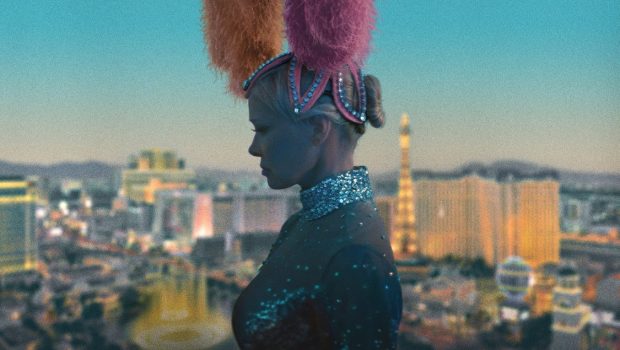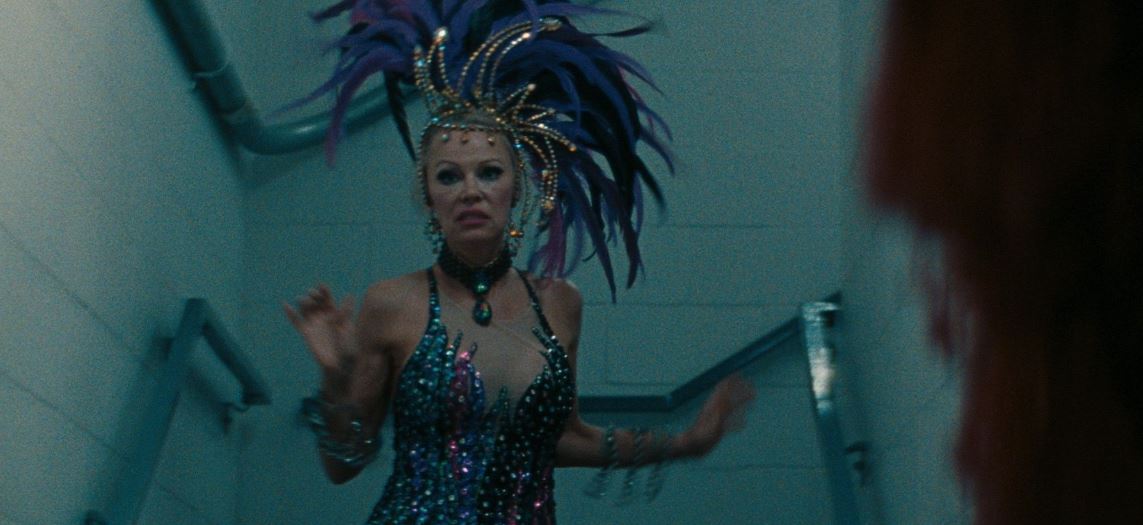The Last Showgirl – Film Review
Reviewed by Damien Straker on the 17h of February 2025
Nixco presents a film by Gia Coppola
Written by Kate Gersten based on Body of Work by Kate Gersten
Produced by Robert Schwartzman, Natalie Farrey, and Gia Coppola
Starring Pamela Anderson, Jamie Lee Curtis, Billie Lourd, Dave Bautista, Brenda Song, Kiernan Shipka, and Jason Schwartzman
Cinematography Autumn Durald Arkapaw
Edited by Blair McClendon and Cam McLauchlin
Music by Andrew Wyatt
Rating: M
Running time: 85 minutes
Release Date: the 20th of February 2025
Pamela Anderson (Baywatch) was nominated for a Golden Globe award for her work in the drama The Last Showgirl. The hype around her performance aside, this is a modest film about older people in show business preparing for the future. The themes of celebrity and adulthood might not surprise you since this film was directed by Gia Coppola. She is the niece of Sofia Coppola. Many of Sofia Coppola’s films, including Lost in Translation (2003), have also explored age and fame from a feminist perspective. This is not to say Gia’s third feature is in the same league. Still, it is hard to fault the workman-like effort. Showgirl was shot on 16mm on a tiny budget of $2 million. It only took 18 days to shoot as well. The exercise alone of seeing Anderson in a different light warrants a viewing.
The titular showgirl in question is a fifty-seven-year-old woman named Shelly (Anderson). Her job is performing in a Las Vegas show called Le Razzle Dazzle. She is accompanied by two younger dancers, Jodie (Kiernan Shipka) and Mary-Anne (Brenda Song). Shelly is also friends with Eddie (David Bautista) who is the show’s producer. The two share a fragile past together. Her best friend is Annette (Jamie Lee Curtis) who left Le Razzle Dazzle six years ago but now works as a cocktail waitress in a casino. When Eddie has dinner with the women one night, they are shocked by a difficult announcement. He says the new venue owners have decided they will be ending the show in two weeks. It leaves everyone, particularly Shelly, rattled. She must now decide on what exactly she is going to do with the last portion of her life. Money is already terribly scarce for her. In the meantime, she tries reconnecting with her grownup daughter, Hannah (Billie Lourd). There is bad blood between them. Fortunately, her daughter is smart enough to be majoring soon in photography.
Gia Coppola’s film is said to be inspired by John Cassavetes’ A Woman Under the Influence (1974). However, this film also owes more to Darren Aronofsky’s film The Wrestler (2008). Mickey Rourke played an ageing wrestling star who reconsidered his work and mortality. He even reconnected with his estranged daughter. This is essentially the exact same story. It is also filmed with the same muddy, fly-on-the-wall shooting style Aronofsky reinvigorated. The dizzying handheld cameras shakily follow the women mostly around narrow corridors. They hurriedly try to alter their outfits for the next stage show. If the intention was to resemble a super low-budget film from an early 2000s video store it achieves that goal. Some of the focus is too blurry. The upside to this shooting style is that it renders Shelly herself and her modest home authentic. Seeing ordinary characters again without an immeasurable amount of money is welcome. It is a break from the exceedingly lavish lifestyles found in various films recently and prestige television. Anora (2024) also showed the gap between the uberwealthy and an ordinary life but in more original ways. Nonetheless, a smart stylistic choice was Coppola’s decision to withhold Le Razzle Dazzle’s final performance until the end. It lets Shelly and company have their moment of glory before the conclusion. Visually, Showgirl is admittedly rough in places. However, the low budget style suits the humble existence in which Shelly lives.
The story, written by Kate Gersten, could have used more finesse in some areas. Most of its eighty-five-minute running time repeats the two issues Shelly faces. She does not have a backup plan for working after the show closes and her relationship with her daughter is brittle. Some of the scenes dramatising her poverty are solid. One example is when she accidentally tears the fabric on her costume. She then notices her paycheque has deducted the costs needed to fix the outfit. Later, she auditions for a different dance role and receives some genuinely hurtful feedback. A man (played by Jason Schwartzman) says she was probably hired when she was younger because she was attractive then. It is impossible not to feel awful for her in these moments. It is interesting that she objects to her younger co-workers joining sexually explicit shows. The characterisation shows she values the genuine glamour and artistry of her work over eroticism alone. This is a neat subversion of Anderson’s own Baywatch image. The film could have relied less on exposition and instead dramatised the backstory and conflict of its characters. Their past grievances are aired through the dialogue when more scenes showing these issues would have rounded out a short movie. The plot also never solidifies or resolves what Shelly will do after the show ends. Though this might be less significant once she knows she still has the support of her friends around her. Nonetheless, less exposition and more resolutions during the main story would have further polished the narrative.
Pamela Anderson deserves credit for turning Shelly into a sympathetic protagonist. She has bravely approached an unglamorous and vulnerable role built around age and poverty. Her best work here is during the quieter scenes. She has a very expressive face that outweighs her otherwise tiny voice. This role could be a solid catalyst for more directors to test her in dramatic stories and expand her emotional range. There are only one or two moments with her that could have used another take. Its fortunate that Jamie Lee Curtis only has a small role in this film. Early on, it’s clear what a dominant force she is on screen. This is not a bad quality but her big personality might have overpowered the story’s meagre scale. There is no doubt though that she knows how to capture our attention. David Bautista shows again that he can play understated lowkey men who are also troubled in unexpected ways. The performances are humane enough to hold our interest despite the slight story. As such, this might not be wildly imaginative cinema but right now having another adult drama about personal support is difficult to ignore.
Summary: The performances are humane enough to hold our interest despite the slight story. This might not be wildly imaginative cinema but right now having another adult drama about personal support is difficult to ignore.








